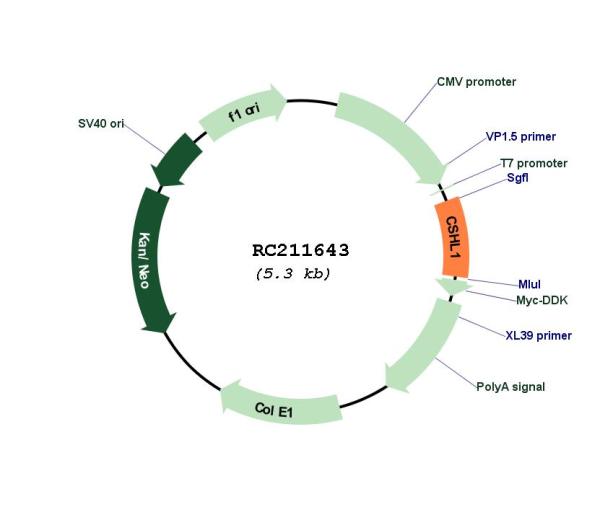CSHL1 (NM_022580) Human Tagged ORF Clone
CAT#: RC211643
CSHL1 (Myc-DDK-tagged)-Human chorionic somatomammotropin hormone-like 1 (CSHL1), transcript variant 4
ORF Plasmid: tGFP
Lentiviral Particles: DDK w/ Puro mGFP w/ Puro
AAV Particle: DDK
"NM_022580" in other vectors (4)
USD 198.00
Specifications
| Product Data | |
| Type | Human Tagged ORF Clone |
| Tag | Myc-DDK |
| Symbol | CSHL1 |
| Synonyms | CS-5; CSHP1; CSL; GHB4; hCS-L |
| Vector | pCMV6-Entry |
| E. coli Selection | Kanamycin (25 ug/mL) |
| Mammalian Cell Selection | Neomycin |
| Sequence Data |
>RC211643 representing NM_022580
Red=Cloning site Blue=ORF Green=Tags(s) TTTTGTAATACGACTCACTATAGGGCGGCCGGGAATTCGTCGACTGGATCCGGTACCGAGGAGATCTGCC GCCGCGATCGCC ATGGCTGCAGACTCTATTCCGACATCCTCCAACATGGAGGAAACGCAGCAGAAATCCAACTTAGAGCTGC TCCACATCTCCCTGCTGCTCATCGAGTCGCGGCTGGAGCCCGTGCGGTTCCTCAGGAGTACCTTCACCAA CAACCTGGTGTATGACACCTCGGACAGTGATGAATATCACCTCCTAAAGGACCTAGAGGAAGGCATCCAA ATGCTGATGGGGAGGCTGGAAGACGGCAGCCACCTGACTGGGCAGACCCTCAAGCAGACCTACAGCAAGT TTGACACAAACTCGCACAACCATGACGCACTGCTCAAGAACTACGGGCTGCTCCACTGCTTCAGGAAGGA CATGGACAAGGTCGAGACATTCCTGCGCATGGTGCAGTGCCGCTCTGTGGAGGGCAGCTGTGGCTTC ACGCGTACGCGGCCGCTCGAGCAGAAACTCATCTCAGAAGAGGATCTGGCAGCAAATGATATCCTGGATT ACAAGGATGACGACGATAAGGTTTAA >RC211643 representing NM_022580
Red=Cloning site Green=Tags(s) MAADSIPTSSNMEETQQKSNLELLHISLLLIESRLEPVRFLRSTFTNNLVYDTSDSDEYHLLKDLEEGIQ MLMGRLEDGSHLTGQTLKQTYSKFDTNSHNHDALLKNYGLLHCFRKDMDKVETFLRMVQCRSVEGSCGF TRTRPLEQKLISEEDLAANDILDYKDDDDKV |
| Chromatograms |
CHROMATOGRAMS
 Sequencher program is needed, download here. |
| Restriction Sites |
SgfI-MluI
Cloning Scheme for this gene
Plasmid Map

|
| ACCN | NM_022580 |
| ORF Size | 417 bp |
| OTI Disclaimer | The molecular sequence of this clone aligns with the gene accession number as a point of reference only. However, individual transcript sequences of the same gene can differ through naturally occurring variations (e.g. polymorphisms), each with its own valid existence. This clone is substantially in agreement with the reference, but a complete review of all prevailing variants is recommended prior to use. More info |
| OTI Annotation | This clone was engineered to express the complete ORF with an expression tag. Expression varies depending on the nature of the gene. |
| Product Components | The ORF clone is ion-exchange column purified and shipped in a 2D barcoded Matrix tube containing 10ug of transfection-ready, dried plasmid DNA (reconstitute with 100 ul of water). |
| Reconstitution | 1. Centrifuge at 5,000xg for 5min. 2. Carefully open the tube and add 100ul of sterile water to dissolve the DNA. 3. Close the tube and incubate for 10 minutes at room temperature. 4. Briefly vortex the tube and then do a quick spin (less than 5000xg) to concentrate the liquid at the bottom. 5. Store the suspended plasmid at -20°C. The DNA is stable for at least one year from date of shipping when stored at -20°C. |
| Reference Data | |
| RefSeq | NM_022580.3 |
| RefSeq Size | 588 bp |
| RefSeq ORF | 420 bp |
| Locus ID | 1444 |
| UniProt ID | Q14406 |
| Cytogenetics | 17q23.3 |
| Domains | hormone |
| Protein Families | Secreted Protein |
| MW | 15.8 kDa |
| Gene Summary | The protein encoded by this gene is a member of the somatotropin/prolactin family of hormones which play an important role in growth control. The gene, along with four other related genes, is located at the growth hormone locus on chromosome 17 where they are interspersed in the same transcriptional orientation; an arrangement which is thought to have evolved by a series of gene duplications. Although the five genes share a remarkably high degree of sequence identity, they are expressed selectively in different tissues. This particular family member is expressed in placental villi, although it was originally thought to be a pseudogene. In fact, alternative splicing suggests that the majority of the transcripts would be unable to express a secreted protein. Alternatively spliced transcript variants encoding different isoforms have been identified. [provided by RefSeq, Jul 2008] |
Documents
| Product Manuals |
| FAQs |
| SDS |
Resources
Other Versions
| SKU | Description | Size | Price |
|---|---|---|---|
| RC211643L3 | Lenti ORF clone of Human chorionic somatomammotropin hormone-like 1 (CSHL1), transcript variant 4, Myc-DDK-tagged |
USD 450.00 |
|
| RC211643L4 | Lenti ORF clone of Human chorionic somatomammotropin hormone-like 1 (CSHL1), transcript variant 4, mGFP tagged |
USD 450.00 |
|
| RG211643 | CSHL1 (tGFP-tagged) - Human chorionic somatomammotropin hormone-like 1 (CSHL1), transcript variant 4 |
USD 350.00 |
|
| SC109124 | CSHL1 (untagged)-Human chorionic somatomammotropin hormone-like 1 (CSHL1), transcript variant 4 |
USD 150.00 |
{0} Product Review(s)
Be the first one to submit a review






























































































































































































































































 Germany
Germany
 Japan
Japan
 United Kingdom
United Kingdom
 China
China




